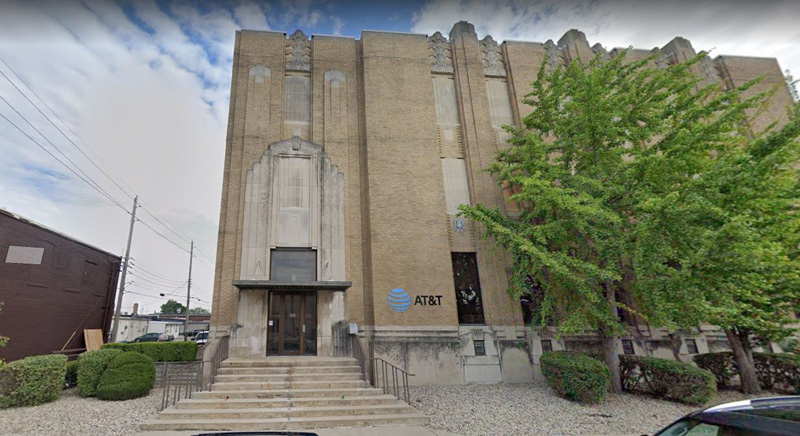1968 Learning & Changing
In 1968 we learned more about each other and about others. We learned that you can't survive on love alone. A little cash comes in handy. I learned a lot from the
Air Force. Susie learned that she had to go back to work for the phone company
for us to survive because my salary just wasn't enough.
1968-late winter and early spring At tech school, we had been trained in fighter aircraft avionics. However, they sent us to the Strategic Air Command to work on supersonic nuclear bombers. Although the B-58 was a much larger aircraft, it's delta wing was shaped like a paper airplane that made it look like an oversize F-102 or F-106 interceptor. 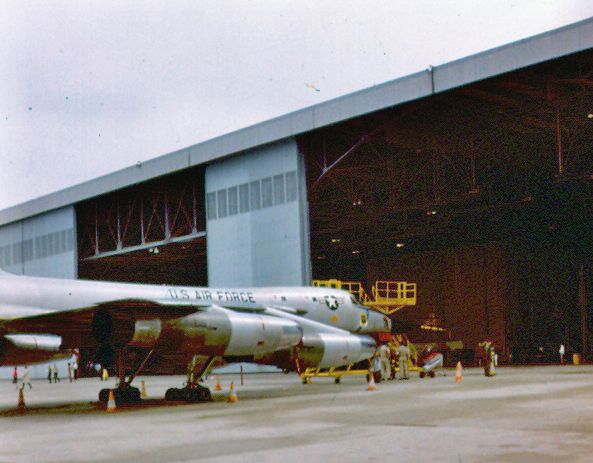 A B-58 Hustler outside a hanger at Grissom AFB, Peru, IN - photo compliments of Art Burr |
| We
all basically had to be retrained on this aircraft's electronics.
The
technology was similar but much newer. Since it was a nuclear
bomber, we each had effectively been "transferred" from protecting the
South Vietnamese from communism to protecting the U.S. from the
Russians. To be in the Cold War fight, we each needed a "Secret" clearance. We were all investigated by the FBI. We were also trained not to discuss anything we did on base with others. I sometimes worked so close to nuclear bombs I could have reached out and touched them. Although digital computers had been invented, they weren't small until the late 1960s. All our computers were analog when we first arrived in 1967. 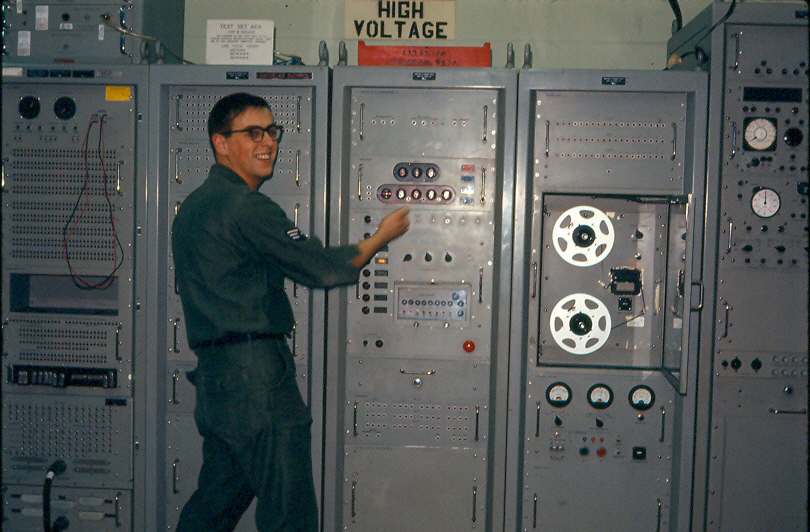 Bob Tracy pointing to the computer test stand in our shop at Grissom AFB - photo compliments of Art Burr |
All the aircraft's mechanical flight controls passed through a device called a "Power Control Linkage Assembly" (PCLA) which we maintained. The device in the photo below attaches the PCLA to the test stand in the above photo. PCLA tests took over 8 hours and stretched from one shift to another. If the test was interrupted, it had to be started over. It required 400 cycle A.C. current created by a huge generator in the adjacent power room. The generator was so sensitive that it would fail if bumped. Unfortunately, there was a metal plate on top convenient for everyone to place their heavy tools. Each time they did so, the generator failed, had to be restarted, and the shop supervisor would come and chew out everyone near it. We all eventually learned to avoid the generator after they placed a crude sign on top threatening the life of anyone who touched it.  PCLA photo compliments of Art Burr |
The PCLA and "Amplifier Computer Assembly" (ACA) were replaceable parts which we repaired in our shop. This "Test Stand" (see photo below) may look like something out of an old 1960s science fiction movie. It was used for putting testing to make sure the ACA and PCLA functioned properly. 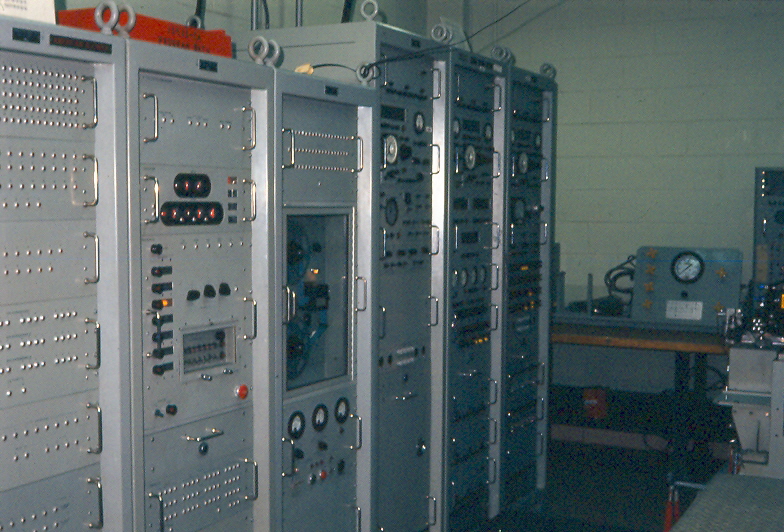 Test Stand photo compliments of Art Burr |
In 1968 and 1969 we went from analog to digital when the Air Force decided the B-58 needed an additional computer. On the table in the foreground of the photo below are both computers. The one on the left is the old, analog ACA. The smaller one on the right was the additional, new "Yaw Amplifier Computer Assembly." We were trained in the digital electronics to know how to work on it. At the time, what was then called "Integrated Circuits" (now called computer chips) were such a new invention that everyone who worked with them, both military and civilian, considered the technology Top Secret. The Air Force added the new "YACA package", as it was called, to prevent potential problems in the old ACA that, under certain conditions, could cause the aircraft to be ripped apart at Mach 2 speeds. Today, I think the tech we worked on that was so secret in 1968 is now installed in every smart phone in the world. It's the tech that helps it know whether you're holding your phone vertically or horizontally.  ACA on left, YACA on right. Photo compliments of Art Burr |
By 1968 my meager salary and Susie's boredom at home were proving to be too much. Like most Air Force wives, Susie felt the need to go back to work. Although we only had one car, she got hired by Indiana Bell as a telephone operator because of her previous employment doing the same thing for South Central Bell. 15 years later, in 1983, I also worked for South Central Bell with a lady in Birmingham named Marlene Rollins from Kokomo. I found out that she, too, had been an operator in Kokomo at the same time as Susie. Funny how our paths crossed. Although I had to have the car to drive to the base 15 miles away, Susie could walk to the phone company central office located at 151 East Taylor St. in Kokomo. It was on the corner where Taylor crosses North Union St. only a half mile away. The walk of several blocks in pleasant weather was fine but she had to walk there no matter what the weather was like. She didn’t have the proper clothing for snow so she had to buy some boots for the snow. They weren’t the best in the world but they were cheap. |
Our apartment was one of 4 in the same building. Next door lived Susie York, a 14-year-old who made no secret of having loose standards. My wife and I were then still quite young ourselves (my wife was only 4 years older than Susie York). After my wife began working for the phone company, the Air Force changed me to evening shift, 3:00PM until 11:00PM. With my wife working day shift and me working evening shift our married life was disrupted. We did not like these changes. During the day, Susie York would come next door ostensibly to use the phone or tell me of something she had done. On one occasion she modeled her new swimsuit for me. I told my wife what this kid was doing. She was furious. Susie York using our phone at 408 S. Union St. - 1968 1968-my birthday We lived on Union St. from late summer of 1967 until spring of 1968. By 1968 I was finally old enough to legally purchase alcohol. Our neighbor Susie York and her teenage friends began coming over begging me to buy liquor which they paid for so we could have drinking parties. Two more teenage boys who lived in an apartment in the back sometimes joined us. The atmosphere at 408 S. Union was not good. My wife began to be afraid there was an evil spirit that resided at 408 S. Union St. At the phone company she asked coworkers where there were other apartments available that we could afford. She desperately wanted to quit work. She figured we could move to another place then get by until I got another promotion. 1968-Mar We moved to 518 W. Walnut St., Apt.#1. It was an upstairs apartment entered via a flight of stairs immediately through the door on the left in the photo below. The apartment owners, Mr. & Mrs. Robert Jaqua, lived downstairs. They entered their apartment through the door on the right at the back of the wrap-around porch in the photo below. |
Here are 2 photos of Susie. The one on the left is her standing on the porch at 408 South Union with her hair dryer in her hand. The other was taken on the porch in front of our apartment door at 518 West Walnut. Click each pic for a larger photo. |
In 1968, I began growing a mustache. Some of the guys at the base grew them. If they were kept trimmed according to regulations, the Air Force allowed them. I felt that I was now a grown man and could grow one if I wanted. What I didn't realize is I didn't have the right genetics. Here's a photo of me with a "mustache." Ron trying to grow a mustache in 1968 |
After a year of not shaving my upper lip, one of the older NCOs looked closer at me, cocked his head to one side, and said, "Are you trying to grow a mustache?" I thought, "What? It took him a year to notice?" I shaved it off. A photo of me on the landing, coming up the stairs to our apartment on Walnut St. |
Our new apartment was roomier and cost the same as the old one. Our only furniture we owned was a little night stand. The places we rented were furnished. The place on Walnut Street was furnished with antiques. I loved them. They reminded me of my Aunt Evelyn's antique shop. On the right in the photo below, Susie is standing in the bedroom on Walnut St. Her hand is on an antique marble top dresser. I'm kneeling next to a little cedar night stand we bought while we were still living on Union Street. I was proud of the way I refinished it. You could see your reflection in it. That was before they invented polyurethane. Mirror finishes were created using "elbow grease", lots of sanding, and coat after coat of varnish. Today, JoAnna now has it at her home. Ron & Susie at Walnut St. in 1969 (notice the BOM in the night stand) |
By August 1967 the Air Force decided to change the names of enlisted ranks. “Airman Third Class” was renamed “Airman”, “Airman Second Class” was renamed “Airman First Class”, and “Airman First Class” was renamed “Sergeant”, sometimes referred to as “buck sergeant” since the next rank up was called “Staff Sergeant.” About this same time, the Air Force worked diligently attempting to get us all to reenlist. They let us know that the 9 months of electronics training and additional on-the-job training we had received was worth thousands of dollars. They offered each of us a cash bonus of several thousand to reenlist. Two fellows in our shop were also skipped over as Sgt. (E4) and promoted directly to Staff Sergeant (E5) in an attempt to get them to re-up. One who went from 2 stripes to 4 was John Kirchmeyer. 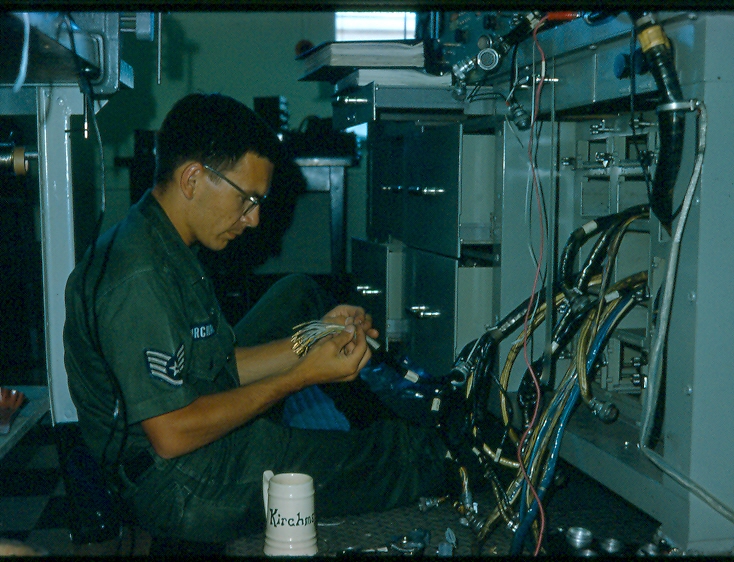 Staff Sergeant John Kirchmeyer |
John Kirchmeyer was a brilliant guy who declined the military's offer to re-enlist. Instead, he used his veterans’ benefits to obtain his college degree. He earned his Ph.D. and taught computer science at the University of Mount Union in Alliance, Ohio before he retired. |
Speaking of guys I got to know while I was stationed at Grissom AFB, one was Art Burr from Michigan. Art and I have remained good friends ever since. Remind me to tell you the story of how Art helped me to develop a good work ethic. Ron and Art Burr doing KP duty at Grissom AFB - 1968 photo |
1968-10-01 On the 1st of October, 1968, I finally got my 3rd stripe and was promoted to Sergeant (E4). We received a pay raise that allowed Susie to quit her job as an operator at Indiana Bell. Money was very tight on one income but we thought we could make it. Right around Christmas of that year, Chet Cleaver came to visit. He was the only one of the teens who lived at 408 S. Union Street who ever came to see us. He came to let us know he was getting married. He was only 17 years old. |
~ END ~
